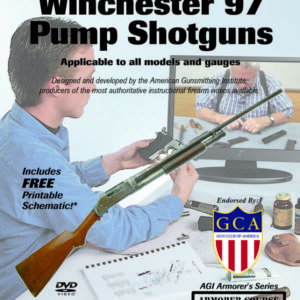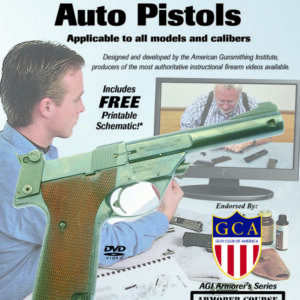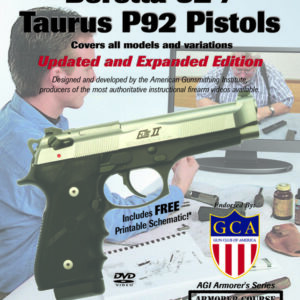Description
Bob Dunlap is a renowned expert on many firearms, including U. S. military rifles. For those of you looking for complete specifications and tolerances for National Match versions of these rifles, and those of you looking for enough information to qualify you as an Armorer for the U. S. Army Marksmanship Unit, this course is NOT for you. This course also does not cover rebarreling, as this is not a unit Armorer function. However, for those of you looking for practical instruction in how to get your rifle completely apart, clean, trouble shoot, make common repairs, and get your gun back together and operating properly with none of those pesky and embarrassing leftover parts, you have come to the right place. Bob uses a cut away gun so that you can actually see how the internal parts function and their relationship to one another. This will help you to understand the design and function of these guns.
If you want the long course, on the design, function and extensive repair of this gun and firearms in general, look into our basic 108 hour Professional Gunsmith Course.
Among the items covered are:
History
- The M1 was originally designed by John Garand in the late 1920s and early 1930s and officially adopted by the military in 1936. It was produced through 1945
- Production was restarted during the Korean War in 1953 and continued through 1957
- The M-14 was adopted in 1957 and production started in 1958. Production continued through approximately 1965
- Approximately 5.5 million M1s were produced and 1.4 million M-14s
- Take a deep breath and a few tranquillizers, those of you who live and breathe Garands, it is NOT one of Bobs favorite guns. Relax and find out why. Be assured he grows more fond of it as the production rolls on
- Bob thinks the M1 is very well thought out and an effective weapon, does he think the same about the M-14
- A suggestion for those of you who wish the very last bit of the most esoteric info on the Garand
Design & Function
- A word of caution for the Garand worshippers still left, the course guns are tools for instruction and will not be handled as if they were the British Crown Jewels
- The Garand is the basis for several follow on guns
- Operation and interaction of the op-rod, bolt stop, magazine catch and follower, and ejection of the empty en bloc clip is explained and demonstrated
- Why the empty clip ejection cling was a design flaw
- What causes the empty clip to eject
- Discussion, demonstration and explanation of the gas system
- Why the gas take-off near the muzzle and the long stroke, low pressure design is a good idea. Does this remind anyone of an upside down AK system? Can we say reliable
- Drawbacks of the design
- The reason Bob really does not like this rifle, a feeling deeply held
- How the op-rod causes the bolt to open and close
- The bolt is inspected, along with the ejection and extractor systems
- The fire control system demonstrated and explained, a Browning A-5 descendent
- How the disconnector/secondary sear controls the two stage trigger pull
- How the safety works
- How the tail of the firing pin functions as a safety
- How the camming cutout in the rear of the bolt also functions as a safety if the bolt is not fully locked up
- How the bolt locks up
- The feeding/extraction/ejection cycle demonstrated and explained
- Barrel fed ramps and chamfers, why they need to be there
- How a snap-over extractor works
Disassembly
- Pay attention to the parts orientation while disassembling, a digital camera is very helpful to take pictures of the parts before you remove them
- Extensive disassembly, variances between different models and generations described parts not removed have removal described, i.e., the op-rod catch , follower, front sight, and barrel
Cleaning & Lubrication
- LATE MENTION – Disassembly of the bolt
- AGI cleaning & lubrication methods shown, along with the reasons for their use
- After cleaning, dry with air gun, a hair dryer, or in the oven on Warm ~185-200 degrees (metal parts ONLY)
- What oil Bob likes to lube the gun with during assembly
Reassembly
- Making sure you have no parts left over
- In many cases the order of assembly is important, Bob shows you the correct order
- Getting the right pieces in the right places, the easiest way possible
- Using the proper tool to help you line up the parts to accept their pins
- How to check for proper extractor function
- How to correct it if does not work properly
- How to check and correct headspace if necessary
- How to do a trigger job that feels good and is safe
- Discussion of the concept of positive and negative sear/hammer engagement
- If you want more info and a complete demonstration of Garand trigger jobs, we have a video course specifically devoted to this operation
- How to achieve proper gas operation on re-welded/salvaged guns
- What to do to get a well worn gun operating correctly
- Tips for improving accuracy, and an explanation of the glass bedding process
- A look at the M-14 and its differences
- Gas system is a hybrid of the Garand and the M-1 Carbine
- Why the op-rod is an improvement
- A look at the Beretta BM-62
Accessories
- Both guns have scope mounts, and butt pad/extenders
- Flash hider/muzzle brakes for both
- Why there are not as many aftermarket accessories for these guns as you might think
Final Thoughts and Wrap-up
If you noticed how often the terms explanation and demonstration are used, you may be getting some idea of why this course is necessary for any Garand owner, or someone who intends to be.




